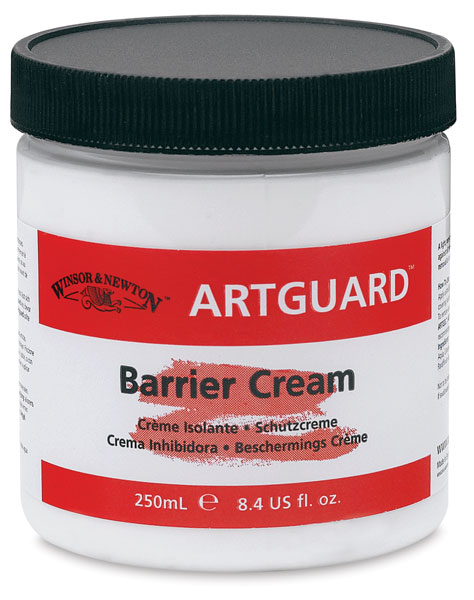Honestly, I didn't care about the safety until the skin on my fingers started to crack. It was painful and the palms were itching. It happened quickly, I was blaming cold weather and trying to cure hands with a moisturizing cream, but it didn't help. Then, after a week of suffering, I saw how I was wiping the brush over hand. It was a habit that I didn't even notice! After I abandoned it and bought a good hand cream from a pharmacy, the skin became normal again.
 |
| A special cream by Winsor & Newton that forms an invisible barrier that protects hands from artists' materials. |
Recently, I read an article called “Unusual Professional Disease”, it was written that it’s common for artists to be poisoned by heavy metals - according to scientists at Princeton University at least 20% of painting pigments have a pronounced toxic or carcinogenic effect. Constant inhalation of lead pigments leads to anemia, kidney, gastrointestinal tract and nervous system damage. Pigments based on cadmium increase the risk of lung cancer. Exposure to chromium leads to ulcers and allergic skin diseases. Pigments based on carbon black are even more dangerous for the skin - with regular exposure they can cause cancer.
Sounds terrifying, but don't panic – most of the pigments nowadays are synthetic imitations of natural pigments. As a replacement of toxic, unstable or expensive pigments manufacturers mix several pigments to create paint. Also, many natural pigments were ousted by artificial. For example, ultramarine blue paint, which was valued more than gold (it was obtained from the mineral called lapis lazuli), in 19th century was replaced by the cheaper artificial ultramarine.
The most dangerous thing that artist has to contact with is a solvent (here is more about solvents). They evaporate pretty fast, so store all solvents tightly capped.
 |
| There is also a safe solvent called Zest-It Oil Paint Dilutant, but I didn't use it |
Let’s turn to advices:
- Ventilate the room - let the fresh air in and let it circulate. Do not keep art materials near an open flame and avoid excessive heating.
- Do not eat, drink or smoke when working.
- Use gloves when you wash the brushes. I know, it's not a pleasure to use them, but it would be much better for you, since you've decided to step on tough guys territory and choose oil based paints instead of water based. If you have 2 small brushes it's ok not to wear gloves, but if you wash 5 brushes - use gloves.
 |
| I use Eye Makeup Remover to get rid of paint on my hands, face and body |
- Don’t wipe the brushes over your hands, body or clothes. I mean it. Don’t do that.
- Do I need to say that you shouldn’t put brushes into your mouth?
- If you want to apply paint with fingers – use a protective cream or gloves.
As you can see, the safety rules are easy to follow. Did you hear all of these quotes about «it's hard to find and easy to lose»? It also refers to your health, so be wise and think about it before something bad happen.

No comments:
Post a Comment